The Campbell Everyday Crochet Sweater Top is a free and easy crochet pattern that is made to measure, size inclusive and designed to be intuitive and beginner friendly.
The Campbell Everyday Crochet Cardigan is one of our most popular crochet cardigan patterns. We have been wanting to create and design a “sister pattern” that is based on the same style and stitch…but as a beautiful and easy sweater top. We are so pleased at how the Campbell Everyday Crochet Sweater Top turned out. It catches the beautiful drape and simplicity of the Campbell Everyday Crochet Cardigan that made it so popular.
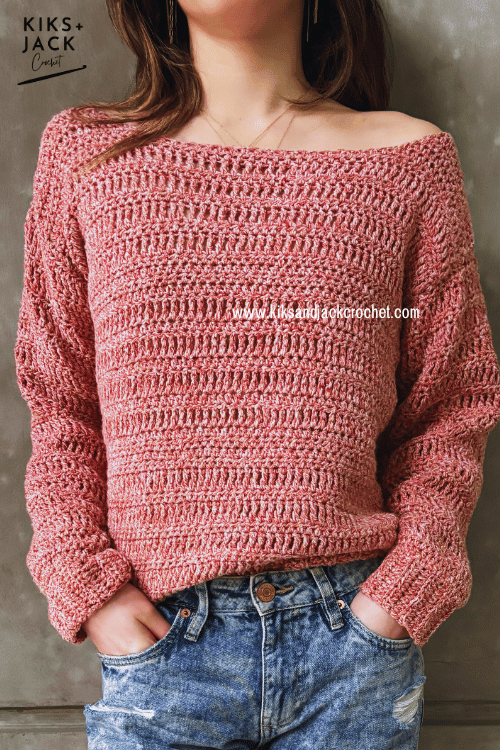
We are trying to keep all our crochet patterns free for everyone, when you access them online. We meet the costs of running this website through coffee donations at https://ko-fi.com/kiksandjackcrochet and ad revenue. When you buy us a cup of coffee, you buy us a cup of motivation. Thank you for keeping us motivated and inspired every day to keep designing free crochet patterns for you.
For the cardigan version, we used a beautiful cotton acrylic blend. We wanted The Campbell Everyday Crochet Sweater Top to have the same feel, lightness and drape – so we decided to once again use another cotton blend – this time in cotton and wool.
The yarn used for this version is called Happy Place Yarn and it really is one of our favourite yarns to work with. It gives incredible drape and softness – no cotton stiffness here. The wool gives it warmth and coziness but it’s still light and airy to work with.
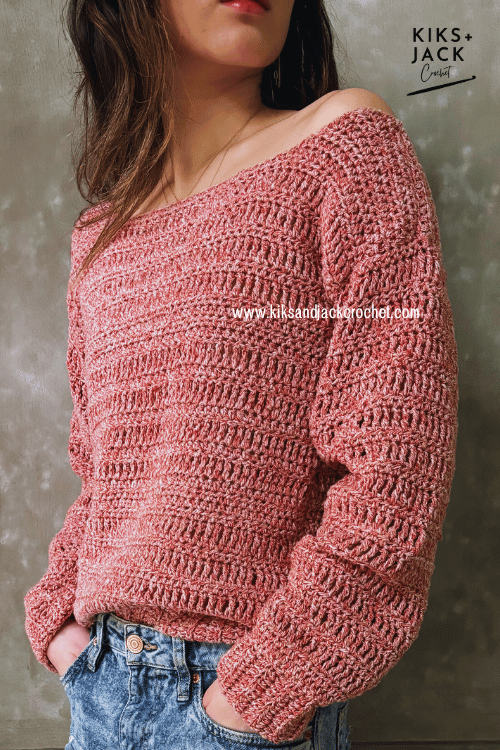
We love both these patterns because they really are true beginner patterns. Our goal has always been to design patterns for those just starting out on their crocheting adventures. We hope everyone aims towards making their own beautiful crochet wardrobe! Starting with a top like this is not only a great addition to your every day wardrobe, but you will be finished fast and on to your next hand made wardrobe garment.
We also show you how to customize the neckline, so you can make it wider or tighter according to your own preference!
This is a pattern at its crochet beginner best! Nothing fussy or tricky. Just beautiful stitching by you to create a gorgeous modern top. Something that is easy and casual to wear and that you know is made by you, customized by you…and you’re the only person who has one!
Let’s get started on the Campbell Everyday Crochet Sweater Top!
Stay up to date with Kiks + Jack Crochet Pattern releases and follow us on social media:
DESCRIPTION of the Campbell Everyday Crochet Sweater Top
The Campbell Everyday Crochet Sweater Top is a casual top and light sweater that can be worn all season. It features a slightly oversized design and long sleeves with ribbing on the sleeve cuffs. The neckline is wide and flattering and can be customized to be tighter or customized to be off the shoulder. The stitches used to create the main panels are simple and beginner friendly.
The Campbell Everyday Crochet Sweater Top is a free and easy crochet pattern available as a size inclusive made to measure pattern. It is a beginner friendly pattern and a sister pattern to the Campbell Everyday Crochet Cardigan.
CROCHET MEASUREMENTS & SIZES
The Campbell Everyday Crochet Sweater Top pattern instructions are made to measure, based on your required measurements.
Kiks + Jack Crochet will always try to write patterns that are “made to measure” (versus graded sized patterns) so that crocheters can get the wonderful benefits of making a garment that fits perfectly. However we do appreciate taking measurements can be inconvenient for some and have also provided standard measurements for those who wish to use it.
To use this pattern you will need the following measurements and you should write them down for easy reference:
Chest/Bust: Measure around the fullest part of your chest/bust. Do not draw the tape too tightly.
Finished length: Measure from just below your waistline (or where you would like the top to end) up to the top of your shoulder.
Arm Length: With arm slightly bent, measure from armpit to wrist (or where you would like the sleeve to end)
Wrist Circumference: Measure from one point on your wrist all around your wrist.
Upper Arm: Measure around the widest section of the upper arm located above the elbow
Standard Sizing (For Reference)
If you would like to use standard sizing for the chest/bust – then for XS (S, M , L, XL, 2XL, 3XL, 4XL, 5XL) use approximately 28-30 (32-34, 36-38, 40-42, 44-46, 48-50, 52-54, 56-58, 60-62) inches or 71-76 (81-86, 91-96, 102-107, 112-117, 122-127, 132-137, 142-147, 152-158) centimetres.
If you would like to use standard sizing for arm length – then for XS (S, M , L, XL, 2XL, 3XL, 4XL, 5XL) use approximately 16.5 (17, 17, 17.5, 17.5, 18, 18, 18.5, 18.5) inches or 42 (43, 43, 44.5, 44.5, 45.5, 45.5, 47, 47) centimetres
If you would like to use standard sizing for upper arm – then for XS (S, M , L, XL, 2XL, 3XL, 4XL, 5XL) use approximately 9.75 (10.25, 11, 12, 13.5, 15.5, 17, 18.5, 18.5) inches or 25 (26, 28, 30.5, 34.5, 39.5, 43, 47, 49.5) centimetres
Note: Designed as a loose fit with significant positive ease.
CROCHET GAUGE
Using a 5mm crochet hook, approximately 13 treble crochets across and approximately 5.5 rows of treble crochet in 4″ x 4″ (10 cm x 10 cm).
Note this pattern is made to measure and can accommodate for different crochet gauges. However we recommend you select a yarn with a similar gauge to this version.
CROCHET MATERIALS for the Campbell Everyday Crochet Sweater Top
This section contains product affiliate links. We may receive a small commission (at no extra cost to you) if you make a purchase after clicking on one of these links.
We promise to only recommend products that we love and that we use.
Yarn brand: Happy Place by Hobbii. Weight 3/Light Worsted/DK. 100g per skein and 273 yards (or 250m) per skein.
Approximately 3.5 skeins or 955 yards (or 875m) used for our garment (approximately S) with a finished width of 18 inches and a finished length of 21 inches.
Color used is Blossom.
This pattern would also work well with Coboo by Lion Brand Yarn.
5 mm crochet hook (US size 8). We use many different crochet hooks and if you are looking for some great budget friendly ergonomic crochet hooks try these from Amazon. It comes in a set and the grip and the shape is amazing for beginner crocheters. However our absolute favourite, slightly more pricey crochet hooks are clover crochet hooks. You can buy then in a set or individually. We started our collection just purchasing the size 4 ,5 and 6.
Measuring Tape. We use a super budget friendly measuring tape. Make sure it has cm and inches (not all patterns are written with both). We are always crocheting on the go so we like our tapes small and compact and we put one in our design area, one in our bag and one in our car. Retractable works best! We use these super cheap mini measuring tapes from Amazon.
Stitch Markers. We use these locking crochet stitch markers from Amazon and these stitch markers that do not lock. They are cheap and colourful.
Blocking Pins. You should buy more pins than you think you need. If you are going to take the time to block don’t skimp on the pins. We like T shaped stainless steel pins that don’t rust when they get wet. We love these blocking T pins from Amazon and the tin means the pins don’t fall out on the floor.
Yarn Needle. Buy blunt needles with large eyes for yarn. We use these Yarn Needles because we like the convenient bottle, they are budget friendly and we get lots of them!
Scissors. We love these thread snippers because they are cheap, we get two of them AND they come with a case (some don’t). Don’t carry these without the case! After you use thread snippers you won’t want to snip with scissors.
CROCHET STITCHES & ABBREVIATIONS
The Campbell Everyday Crochet Sweater Top pattern uses US terminology.
ch = chain (With one loop on your hook, yarn over and pull through the loop)
sc = single crochet (Insert hook into desired stitch. Yarn over and pull through the stitch. You now have two loops on your hook. Yarn over and pull through all two loops)
hdc = half double crochet (Yarn over and insert hook into desired stitch. Yarn over and pull through the stitch. You now have three loops on your hook. Yarn over and pull through all three loops)
tc = treble crochet (Yarn over once and then yarn over again. Insert hook into desired stitch. Yarn over and pull through the stitch. You should now have 4 loops on your hook. Yarn over and pull through two loops. You should now have 3 loops on your hook. Yarn over and pull through two loops. You should now have two loops on your hook. Yarn over and pull through the remaining two loops).
BLO = back loop only
tch = turning chain
st = stitch
sk = skip stitch
* = repeat the instructions following the * as directed
Note unless stated otherwise in this pattern the Campbell Everyday Crochet Sweater Top, turning chains do not count as a stitch if there are 1 or 2 chains and the turning chain does count as a stitch if there are 3 or 4 chains.
SUMMARY of CONSTRUCTION for The Campbell Everyday Crochet Sweater Top
The Campbell Everyday Crochet Sweater Top is made by first crocheting a back panel and then crocheting a front panel. We will crochet the panels bottom up starting with a bottom ribbing. We will then crochet the ribbing for the sleeves and then continue to crochet the sleeves panel on to the ribbing.
Next we will seam the front panel and the back panels at the shoulder and then seam the sides and the sleeves directly on to the panels. We will finish off the neckline with a simple crochet edge.
PERMISSIONS AND COPYRIGHT for The Campbell Everyday Crochet Sweater Top
You may not publish or share any pattern on this website www.kiksandjackcrochet as your own including this pattern The Campbell Everyday Crochet Sweater Top. Except as permitted by the copyright law applicable to you, you may not reproduce or communicate any of the content on this website, including files downloadable from this website, without the permission of the copyright owner, Kiks + Jack Crochet.
You may not use any Kiks and Jack Crochet photo as your own photo.
You may crochet items to sell using The Campbell Everyday Crochet Sweater Top pattern upon permission by email at [email protected]. Please link back to this post in exchange.
Pattern Instructions for The Campbell Everyday Crochet Sweater Top
Crochet the Main Back Panel Ribbing
The height of our ribbing is approximately 2 inches. Based on our gauge this is approximately 12 chains. However you can adjust the number of chains if you want to change the height of the ribbing or you are using a yarn with a different gauge.
ch 12
Row 1: hdc in 3rd ch from hook, hdc in each ch across until end. Turn
Row 2: ch2, hdc BLO in each st across, hdc in the entire st on the last st. Turn
Repeat row 2 until the total length of the ribbing is equal to HALF of your “Chest/Bust Measurement” + 2 inches.
Example: Our chest/bust measurement = 32 inches around. Half of 32 inches = 16 inches. We keep repeating row 2 until the total length of the ribbing reaches 18 inches (16 + 2 = 18 inches)
Count the total number of rows.
Example: We counted a total of 40 rows to achieve a length of 18 inches.
It’s a great time to do an intuitive check to see if you are completely happy with the width of the cardigan before you crochet any further. Place the ribbing up against you to see if the width (length of ribbing) is right for you. If you would like it to be wider and more oversized, crochet a few more rows. If you would like the ribbing to be tighter and less oversized, then you can frog (unravel) a few rows.
Do not fasten off.
Crochet the Main Back Panel
You will now crochet down the long side of the ribbing that you just crocheted.
To calculate the number of stitches that you will crochet down the long side of the ribbing, calculate as follows:
| Calculation | Kiks + Jack Crochet Example |
| Count the number of rows in your ribbing | We crocheted 40 rows in our ribbing (to achieve 18 inches) |
| Multiply this by 1.5 (round up if necessary) | 40 X 1.5 = 60 stitches |
Row 1: Using the working yarn, ch2, hdc into the first st, hdc across the ribbing the number of stitches you calculated above in total. Turn
In K+J example above we will crochet 60 half double crochets across the long side ribbing. You may want to divide your ribbing into 4 quarters using stitch markers and ensure you are crocheting approximately 25% of your total stitches in each quarter. This will help you ensure you are crocheting evenly across your ribbing.
Row 2: ch2, hdc in first st, hdc across the row until the last st. Turn
Row 3: ch3, tc in the 2nd st, tc across the row until the last st. Turn
Row 4: ch2, hdc in first st, hdc across the row until the last st. Turn
Row 5: repeat row 3 (tc row)
Row 6: repeat row 4 (hdc row)
Row 7: repeat row 3 (tc row)
Row 8: repeat row 4 (hdc row)
Row 9: repeat row 3 (tc row)
Row 10-13: repeat row 4 (hdc row x 4)
Repeat row 3-13 in that order until the back panel (including ribbing) is equal to your “Finished Length Measurement” – 2 inches. Try to finish on a triple crochet row as the neckline will be crocheted using hdc rows.
Fasten off.
Kiks + Jack’s version: Our “Finished Length Measurement” is 21 inches. Therefore we crochet rows 3-13 until the total back panel including the ribbing equals 21 – 2 = 19 inches with the final row being on a row 9.
Crochet the Front Panel
Repeat all the instructions under the Back Panel except stop when your front panel (including ribbing) is equal to your “Finished Length Measurement” – 3 inches. Try to finish on a triple crochet row as the neckline will be crocheted using hdc rows.
Crochet the Neckline on the Back and and Front Panel
We will now measure out and crochet the neckline for the two panels. Crocheting two panels first without the neckline allows you “try it on” (see below) and ensure you get the perfect neckline width before you crochet the neckline on to the two panels.
Measure approximately 4 inches in from the left edge of the back panel and place a locking stitch marker (we will be adjusting the exact inches that is right for you shortly). This will be the start of your neck opening.
Repeat the same on the right side of the back panel.
Repeat the same on the front panel on both sides.
Attach the two panels together lining up the 4 stitch markers and securing the panels together with the locking stitch markers. Place the panels over your head and double check you are happy with the neck opening. If you would like the neckline to be tighter, then move the stitch markers closer to your neck. If you would like the neckline to be wider, then move the stitch markers away from your neck. Make sure it is the same distance (use a measuring tape) on either side and on the front and back panel.
Kiks + Jack’s version: We crocheted approximately size XS/S and measured 4.5 inches from each side. This gave a moderate neckline that allowed us to wear it slightly off the shoulder on one side.
Now that we have measured the neckline, we will start to crochet it. Detach the two panels, however keep the four stitch markers marking out the neckline on your panels. Start with the back panel and attach the yarn to the first stitch near the left shoulder.
For the neckline you are reducing a stitch on every other row. See “Crochet Stitches & Abbreviations” above for a guide on how to crochet a hdc2tog.
Row 1: ch2, hdc in the 1st st and in each st (crocheting towards the neckline stitch marker), stopping 1 stitch before the st with the stitch marker, hdc2tog the next 2 stitches. Turn
Row 2: ch2, hdc in the next st and across to the end (heading away from the neckline stitch marker). Turn
Row 3: ch2, hdc in the 1st st and in each st (crocheting towards the neckline), stopping 1 stitch before the end, hdc2tog the next 2 stitches. Turn
Row 4: repeat row 2
Repeat rows 3-4 in that order until your back panel for this side is equal to your “Finished Length Measurement“.
You can do a quick check here again on the neckline. Hold it up against the top of your shoulders and if you think you need to crochet an additional rows do so. Remember you will need to repeat this on the other side. Also note this is the back panel so the neckline should be slightly higher than the front panel.
Fasten off.
Repeat the same on the other side of your back panel.
Repeat rows 1 – 4 on the front left side of the front panel, then repeat rows 3-4 in that order until your front panel for this side is equal to your “Finished Length Measurement” ie. make sure it matches the finished length for the back panel especially if you made any adjustments. We like to place the front panel on top of the back panel to double check the finished lengths are the same.
Repeat the same on the right side of the front panel.
Note: The neckline is designed so that you should crochet slightly more rows for your front panel vs your back panel.
In Kiks + Jack’s version we crocheted 5 rows for the back panel neckline and 7 rows for the front panel.
Crochet the Sleeve Panel (Make 2)
Crochet the Sleeve Panel Ribbing
ch 12
Tip: Remember the height of our ribbing is approximately 2 inches using an initital chain of 12. You may have adjusted yours and should crochet the same number here as your front and back panel.
Row 1: hdc in 3rd ch from hook, hdc in each ch across until end. Turn
Row 2: ch2, hdc BLO in each st across, hdc in the entire st on the last st. Turn
Repeat row 2 until the total length of the ribbing is equal to your “Wrist Circumference Measurement” + 2 inches. Make sure it fits comfortably and is not too tight.
Count the number of rows (we crocheted 20 rows).
Do not fasten off.
Crochet the Main Sleeve Panel
Note: The sleeves are crocheted as one row of treble crochet and one row of half double crochet. This is a different pattern to the main panel.
You will now crochet down the long side of the ribbing using the working yarn.
Row 1: ch1, 2sc in every row (in our example we would crochet 20 rows x 2 = 40 sc. It will be tight)
Row 2: ch2, hdc in first st, hdc across the row until the last st. Turn
Row 3: repeat row 2
Row 4: ch3, tc in the 2nd st, tc across the row until the last st. Turn
Repeat row 3-4 until the total length of your sleeve, including the cuff, is equal to your “Arm Length Measurement“.
Optional Sleeve Width Increase: After you have crocheted rows 3-4 for approximately halfway up your forearm check the width of your sleeve panel. If you think you need to increase this width to fit the widest part of your arm (usually the bicep and called the upper arm measurement) you can increase 2 stitches on every hdc row (i.e on every row 2). You would do this on Row 2 by crocheting 2hdc at the start of the row and 2hdc at the end of the row. You can keep crocheting these additional 2 stitches per row for every Row 2 until the width of your sleeve panel increases to your required width. We did not need to do this for Kiks + Jack’s version, so this is optional.
Fasten off.
We will show you how to check the sleeve length again under “Assembly” below so that you can ensure you have the perfect fit.
Remember you need to crochet two identical sleeve panels.
Assembling The Campbell Everyday Crochet Sweater Top
Kiks + Jack Crochet highly recommends blocking all your panels before assembling The Campbell Everyday Crochet Sweater Top. Blocking your panels will set your panels to the shape and size you want and give it a professional look.
Step 1: Seam the Front and Back Panel at the shoulder. Place the front and back panels together with the right sides facing together. With a yarn needle, seam the two panels together across the shoulders starting from the edge and across. Fasten off.
Step 2: Line up your sleeves at the midway point to the shoulder and seam. Open up the two panels (now seamed at the shoulders) so that the right side is facing the floor and the wrong side is facing upwards. Take one of your crocheted sleeves and fold it in half lengthways. Place a stitch marker at the top of your sleeve at the centre point. With the wrong side of the sleeve facing up, attach this stitch marker to the left edge of the left shoulder seam.
Customization Tip: It is a good time to check the length of your sleeve. You can “seam” it with a few locking stitch markers to the main panel. Try it on. If you would like the sleeve to be longer (eg. some like the cuff to be almost at the knuckles vs the wrist), you can remove the knot on your sleeve panel (where you fastened off) then add a few more rows on to your sleeve. Or you can reduce rows if you like your sleeves shorter by removing the knot first and pulling out (frogging) a few rows. Make sure you do the same on the second sleeve so they are identical.
When everything is perfect, using a yarn needle and matching yarn, seam the sleeves to the main panels (wrong side facing up) – see first diagram below (for illustrative purposes only).
Do the same on the right side with the other sleeve.
Step 3: Seam the sides of the sweater and the bottom of the sleeve together. Fold the two panels and sleeve panels at the seamed shoulders so that your sweater is facing wrong side out. With a yarn needle and matching yarn, seam the sides of the two panels together up to the armpit and along the bottom of the sleeve. See second diagram below (for illustrative purposes only)
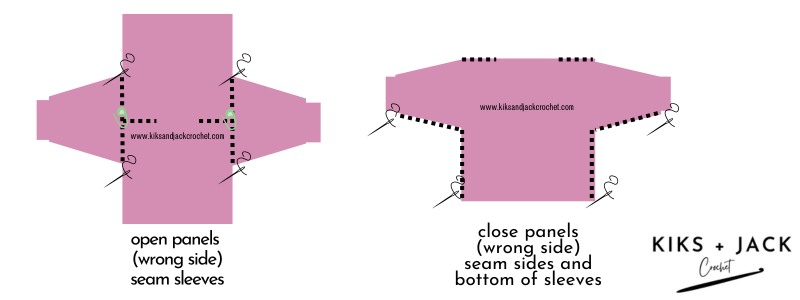
Step 4 (optional): Crochet around the neckline. Just like it’s sister pattern, The Campbell Everyday Crochet Cardigan, we wanted to keep the neckline simple. Attach a yarn to the side of the neckline and crochet as follows:
Round 1: ch2, sc in 1st st, sc around the neckline (it is more important to be even than the actual number of sc around), sl st to the 1st sc.
Round 2 (optional, we did not do for our version): repeat round 1
Fasten off.
Finish & Celebrate The Campbell Everyday Crochet Sweater Top
Weave in all your ends.
Congratulations you have finished The Campbell Everyday Crochet Sweater Top and we hope you enjoyed this free crochet pattern.
We are trying to keep all our crochet patterns free for everyone, when you access them online. We meet the costs of running this website through coffee donations at https://ko-fi.com/kiksandjackcrochet and ad revenue. When you buy us a cup of coffee, you buy us a cup of motivation. Thank you for keeping us motivated and inspired every day to keep designing free crochet patterns for you.
It would be amazing to see a photo of your completed work on instagram. Tag us @kiksandjackcrochet and follow us on Pinterest, Instagram or Facebook for new pattern releases by clicking on the icons below:
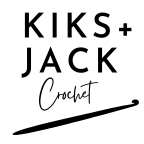
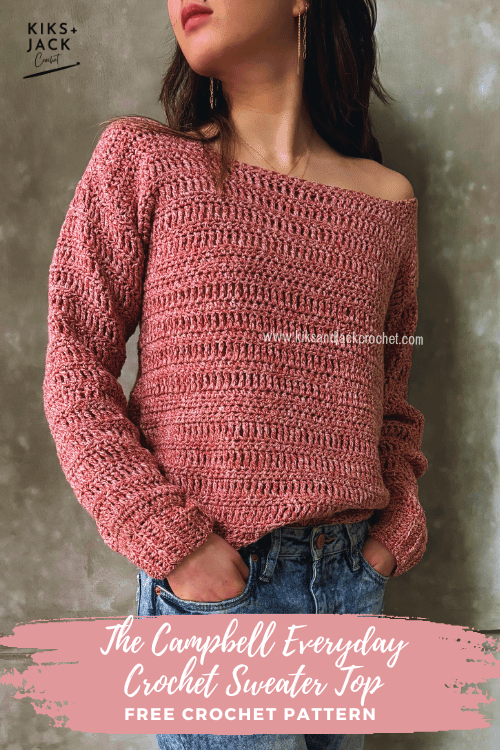
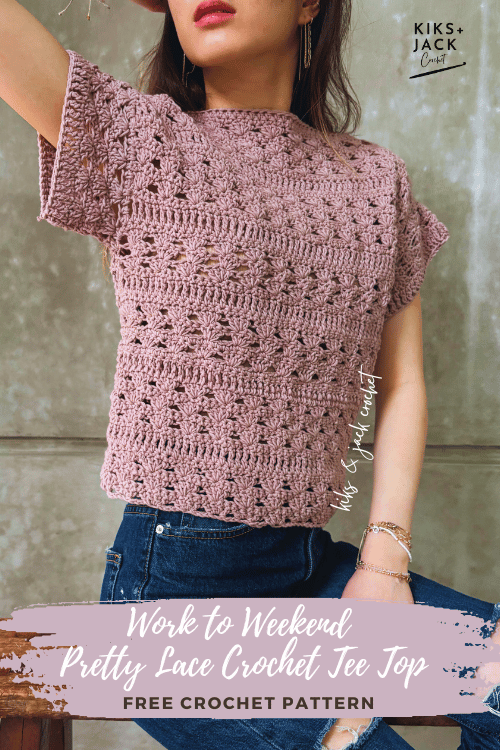
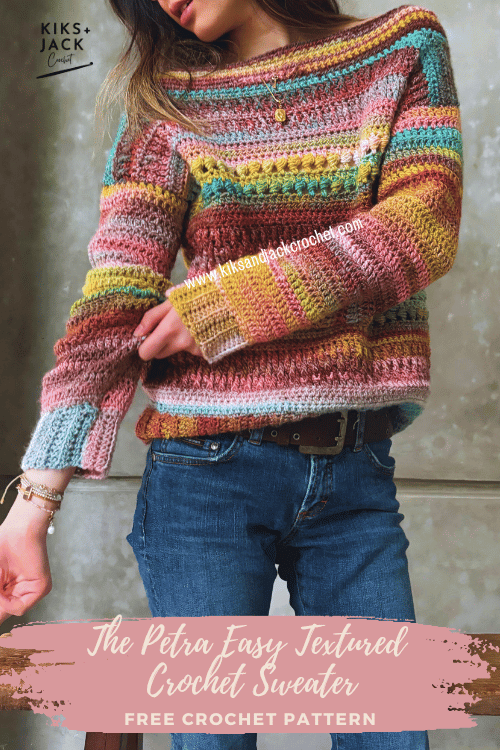
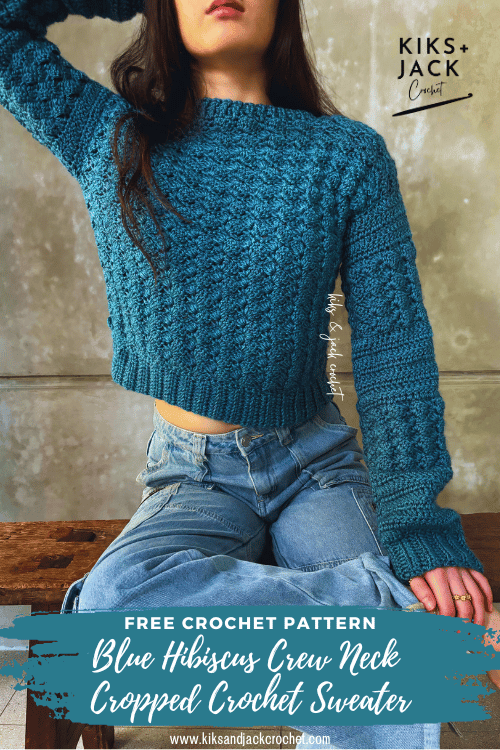
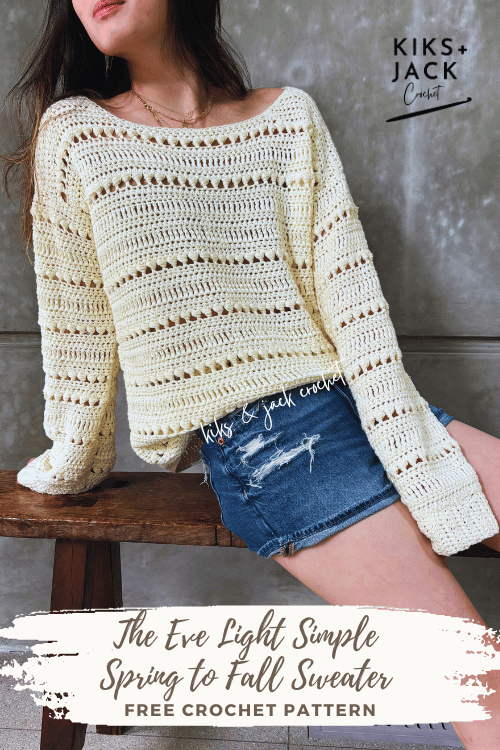
3 thought on “The Everyday Crochet Sweater Top Free Pattern”
Comments are closed.